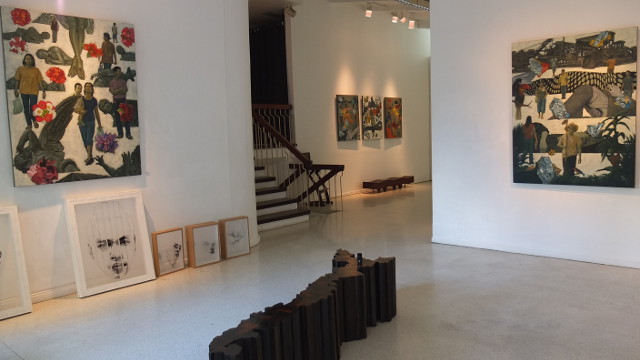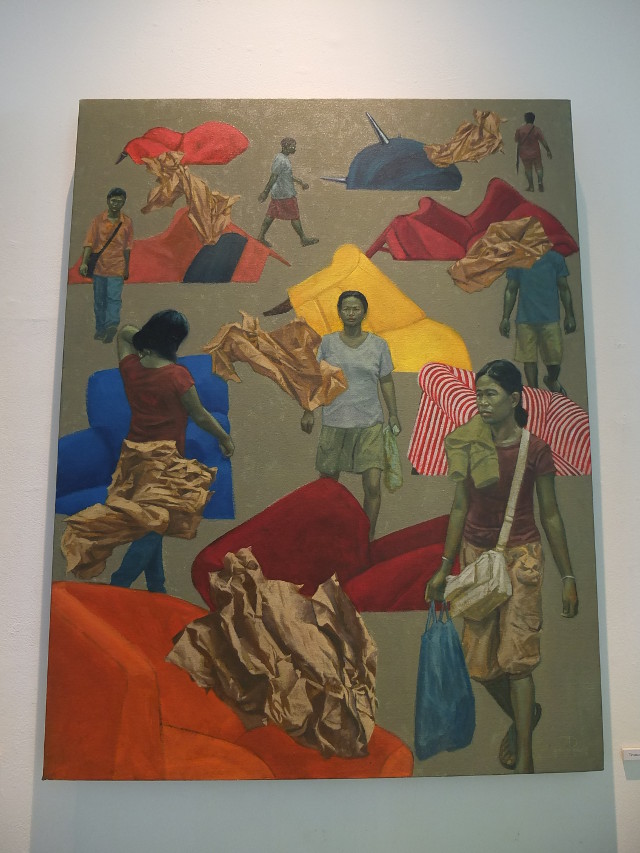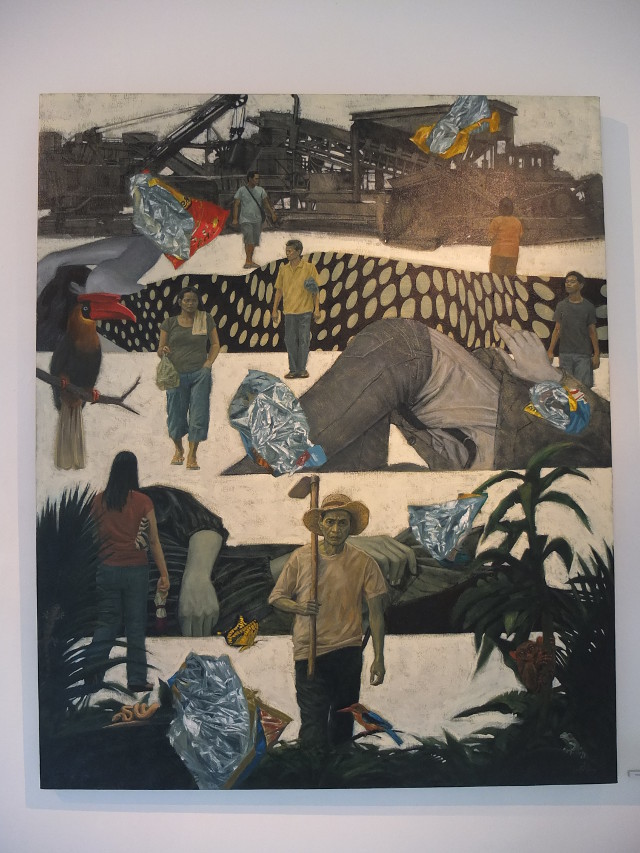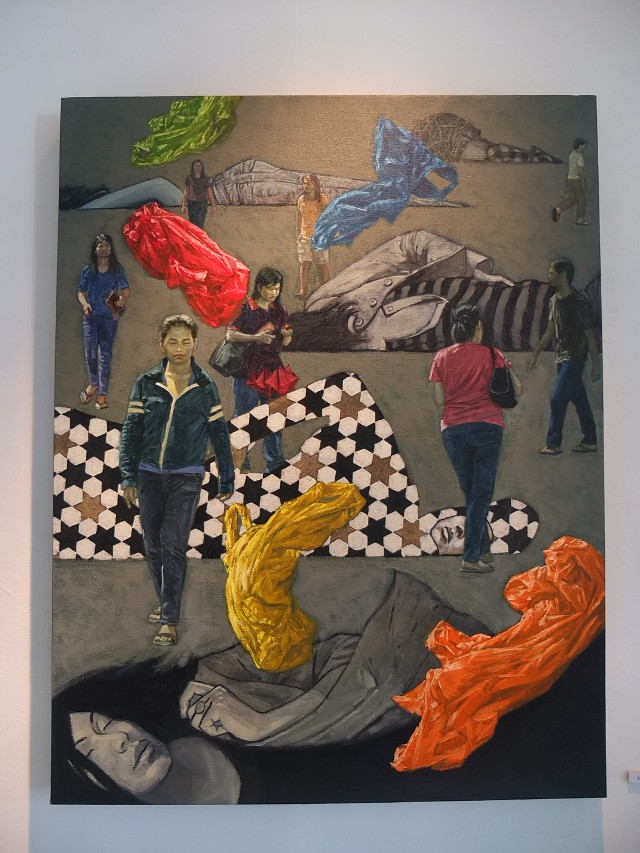SUMMARY
This is AI generated summarization, which may have errors. For context, always refer to the full article.

MANILA, Philippines – Filipino painter Antipas “Biboy” Delotavo took on a subject that touches the lives of every Filipino: the mall and its impact on Filipino lifestyle and culture.
In “Mallcontents,” his 13th one-man exhibit at Artinformal Gallery in Greenhills, Mandaluyong, busy shoppers walk through surreal unbound space populated by floating merchandise.
His mastery of portraiture is made evident by the wonderfully rendered expressions of his subjects. His deft hand has made their bored, squinting, lost, determined, or tired expressions startlingly familiar — or at least, as familiar as the person lining up behind you at the department store cashier.
The mall as consumerist symbol
For Delotavo, the mall is more than the Filipino’s favorite hangout. It is a symbol of Filipino contemporary culture.
“The consumer culture becomes a vital driving force in our economy,” Delotavo tells Rappler in an email interview.
“The Philippines is more of a consumer society rather than an industrial one. We are not much in manufacturing compared to progressive countries in Asia. We patronize their products through the malls.”
As the exhibit’s title implies, Delotavo thinks mall culture points to a deficiency or a disjointedness in Filipino society and consumerism.
“The Mall is a major arbiter of taste among consumers in the way it promotes commercial goods aggressively and creatively outside the malls through billboards and mass media,” he explains.
“The power of advertisement convinces us and the unnecessary becomes a necessity that we cannot live without. I am looking beneath the cosmetic surface of this artificial culture — the alienation of the marginalized majority of financially-challenged Filipinos.
“Frustrations and unhappiness set in if you cannot afford those beautiful things found in the places you are most comfortable in. ‘Mallcontents’ was conceived in this perspective.”
Talk turned to the role of malls in contemporary Filipino society. It’s no secret that, today, there are more malls than open public parks in the Philippines. There are shopping malls even in small towns. The mall has firmly established itself in the lifestyle and daily pasttime of Filipino families.
“Malls have replaced the public parks of the old days as the popular gathering place for leisure, recreation, or meditation,” declares Delotavo, a self-confessed mall-goer.
“It is relatively safe, temperature controlled, self-contained, and deliberately designed with all the convenience to lure shoppers to spend their money.”
The disjointedness brought about by mall culture is evident in his paintings where shoppers toting shopping bags attempt to navigate their way through a maze of floating or sinking goods.
In “Tronong Naghahari,” the subjects make their way around sinking sofas and arm chairs. Paper wrappers or perhaps pieces of fabric float around; one covers a man’s face.
In “Sindak sa Kalikasan,” a farmer on the foreground walks towards a dark wilderness while, behind him, shoppers walk amidst an industrial background through which fall shiny junk-food wrappers.
The effect is disconcerting and frightening, as if Delotavo’s subjects will never find their way out of the maze; or worse, as if they do not even know they are lost.
Master of faces
Born in Iloilo in 1954, Delotavo studied Fine Arts at the Philippine Women’s University in Manila. His skill and vision as an artist earned him numerous awards including the Gawad CCP sa Sining Biswal in 1990 and 3 medals from Art Association of the Philippines.
A highly-gifted portraitist, he was commissioned by the Malacañang Museum to paint the official portrait of former President Corazon Aquino.
Delotavo knew his forte was figurative art early on in his life.
“I knew I had it even before I learned how to write in the way people reacted to my drawings excitedly,” he shares.
“I would amuse myself by drawing celebrities, like Dolphy or Joseph Estrada, which I copied from fan magazines and letting people guess who they were. I always impressed them as they complemented me on how I got the likeness of the person.”
His experiments in portraiture led him to a continuing fascination for “the character of sun-burnt, work-ridden face of Filipino workers — the exact opposite of the healthy, nourished faces of rich Filipinos I painted. Nevertheless, they are the same humanity divided only by different circumstance.”
Words for the young
Mall culture plays an even bigger role in the lives of young Filipinos who can definitely take something from Delotavo’s exhibit.
The mall and its continuous and growing popularity among younger generations says much about today’s consumerist lifestyles.
“The pressure to earn more especially in the younger generation who grew up in the age of malls and the stress of their accustomed lifestyle is greater than ever compared to my generation who grew up in the ’60s and ’70s,” said Delotavo.
“The temptation to improve their purchasing power through questionable means is always real. Progress is desirable and inevitable but it has its unpleasant trade-offs. That is reality.” – Rappler.com
Antipas Delotavo’s ‘Mallcontents’ is on exhibit until April 22 at Artinformal #277 Connecticut St, Greenhills East, Mandaluyong City.
Add a comment
How does this make you feel?




There are no comments yet. Add your comment to start the conversation.